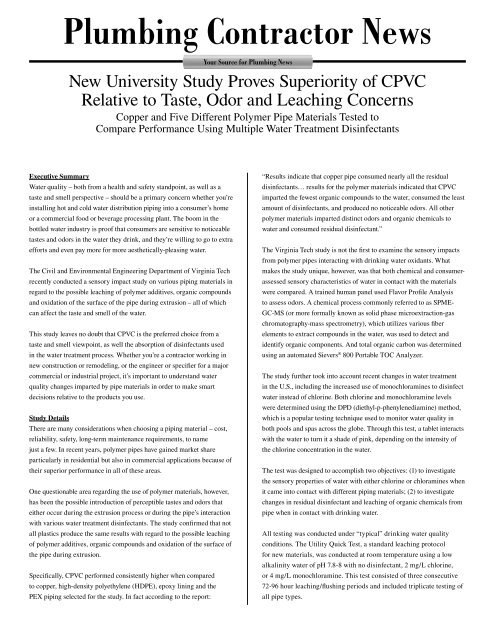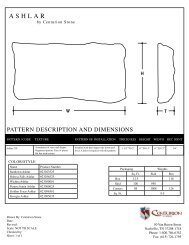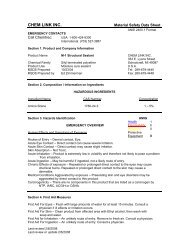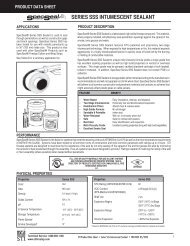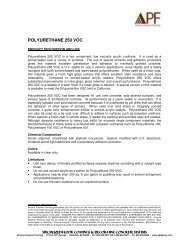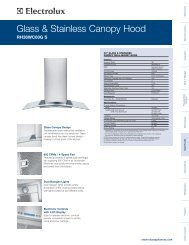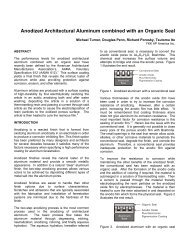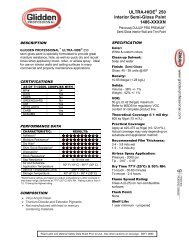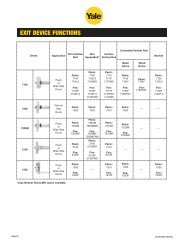Study of CPVC Taste, Odor and Leach...
Study of CPVC Taste, Odor and Leach...
Study of CPVC Taste, Odor and Leach...
Create successful ePaper yourself
Turn your PDF publications into a flip-book with our unique Google optimized e-Paper software.
Executive Summary<br />
Water quality – both from a health <strong>and</strong> safety st<strong>and</strong>point, as well as a<br />
taste <strong>and</strong> smell perspective – should be a primary concern whether you’re<br />
installing hot <strong>and</strong> cold water distribution piping into a consumer’s home<br />
or a commercial food or beverage processing plant. The boom in the<br />
bottled water industry is pro<strong>of</strong> that consumers are sensitive to noticeable<br />
tastes <strong>and</strong> odors in the water they drink, <strong>and</strong> they’re willing to go to extra<br />
efforts <strong>and</strong> even pay more for more aesthetically-pleasing water.<br />
The Civil <strong>and</strong> Environmental Engineering Department <strong>of</strong> Virginia Tech<br />
recently conducted a sensory impact study on various piping materials in<br />
regard to the possible leaching <strong>of</strong> polymer additives, organic compounds<br />
<strong>and</strong> oxidation <strong>of</strong> the surface <strong>of</strong> the pipe during extrusion – all <strong>of</strong> which<br />
can affect the taste <strong>and</strong> smell <strong>of</strong> the water.<br />
This study leaves no doubt that <strong>CPVC</strong> is the preferred choice from a<br />
taste <strong>and</strong> smell viewpoint, as well the absorption <strong>of</strong> disinfectants used<br />
in the water treatment process. Whether you’re a contractor working in<br />
new construction or remodeling, or the engineer or specifier for a major<br />
commercial or industrial project, it’s important to underst<strong>and</strong> water<br />
quality changes imparted by pipe materials in order to make smart<br />
decisions relative to the products you use.<br />
<strong>Study</strong> Details<br />
Plumbing Contractor News<br />
There are many considerations when choosing a piping material – cost,<br />
reliability, safety, long-term maintenance requirements, to name<br />
just a few. In recent years, polymer pipes have gained market share<br />
particularly in residential but also in commercial applications because <strong>of</strong><br />
their superior performance in all <strong>of</strong> these areas.<br />
One questionable area regarding the use <strong>of</strong> polymer materials, however,<br />
has been the possible introduction <strong>of</strong> perceptible tastes <strong>and</strong> odors that<br />
either occur during the extrusion process or during the pipe’s interaction<br />
with various water treatment disinfectants. The study confirmed that not<br />
all plastics produce the same results with regard to the possible leaching<br />
<strong>of</strong> polymer additives, organic compounds <strong>and</strong> oxidation <strong>of</strong> the surface <strong>of</strong><br />
the pipe during extrusion.<br />
Your Source for Plumbing News<br />
New University <strong>Study</strong> Proves Superiority <strong>of</strong> <strong>CPVC</strong><br />
Relative to <strong>Taste</strong>, <strong>Odor</strong> <strong>and</strong> <strong>Leach</strong>ing Concerns<br />
Copper <strong>and</strong> Five Different Polymer Pipe Materials Tested to<br />
Compare Performance Using Multiple Water Treatment Disinfectants<br />
Specifically, <strong>CPVC</strong> performed consistently higher when compared<br />
to copper, high-density polyethylene (HDPE), epoxy lining <strong>and</strong> the<br />
PEX piping selected for the study. In fact according to the report:<br />
“Results indicate that copper pipe consumed nearly all the residual<br />
disinfectants… results for the polymer materials indicated that <strong>CPVC</strong><br />
imparted the fewest organic compounds to the water, consumed the least<br />
amount <strong>of</strong> disinfectants, <strong>and</strong> produced no noticeable odors. All other<br />
polymer materials imparted distinct odors <strong>and</strong> organic chemicals to<br />
water <strong>and</strong> consumed residual disinfectant.”<br />
The Virginia Tech study is not the first to examine the sensory impacts<br />
from polymer pipes interacting with drinking water oxidants. What<br />
makes the study unique, however, was that both chemical <strong>and</strong> consumer-<br />
assessed sensory characteristics <strong>of</strong> water in contact with the materials<br />
were compared. A trained human panel used Flavor Pr<strong>of</strong>ile Analysis<br />
to assess odors. A chemical process commonly referred to as SPME-<br />
GC-MS (or more formally known as solid phase microextraction-gas<br />
chromatography-mass spectrometry), which utilizes various fiber<br />
elements to extract compounds in the water, was used to detect <strong>and</strong><br />
identify organic components. And total organic carbon was determined<br />
using an automated Sievers ® 800 Portable TOC Analyzer.<br />
The study further took into account recent changes in water treatment<br />
in the U.S., including the increased use <strong>of</strong> monochloramines to disinfect<br />
water instead <strong>of</strong> chlorine. Both chlorine <strong>and</strong> monochloramine levels<br />
were determined using the DPD (diethyl-p-phenylenediamine) method,<br />
which is a popular testing technique used to monitor water quality in<br />
both pools <strong>and</strong> spas across the globe. Through this test, a tablet interacts<br />
with the water to turn it a shade <strong>of</strong> pink, depending on the intensity <strong>of</strong><br />
the chlorine concentration in the water.<br />
The test was designed to accomplish two objectives: (1) to investigate<br />
the sensory properties <strong>of</strong> water with either chlorine or chloramines when<br />
it came into contact with different piping materials; (2) to investigate<br />
changes in residual disinfectant <strong>and</strong> leaching <strong>of</strong> organic chemicals from<br />
pipe when in contact with drinking water.<br />
All testing was conducted under “typical” drinking water quality<br />
conditions. The Utility Quick Test, a st<strong>and</strong>ard leaching protocol<br />
for new materials, was conducted at room temperature using a low<br />
alkalinity water <strong>of</strong> pH 7.8-8 with no disinfectant, 2 mg/L chlorine,<br />
or 4 mg/L monochloramine. This test consisted <strong>of</strong> three consecutive<br />
72-96 hour leaching/flushing periods <strong>and</strong> included triplicate testing <strong>of</strong><br />
all pipe types.
Results comparing the polymer materials indicated<br />
that <strong>CPVC</strong> imparted the fewest organic compounds<br />
to the water, consumed the least amount <strong>of</strong><br />
disinfectants, <strong>and</strong> produced no noticeable odors.<br />
All other polymer materials imparted distinct<br />
odors <strong>and</strong> organic chemicals into the water <strong>and</strong><br />
were shown to consume residual disinfectant.<br />
Of all the materials tested, epoxy lining had the<br />
most dramatic effect on water quality, imparting a<br />
moderate “plastic-putty-glue” odor, leaching 0.4-<br />
0.6 mg/L organic carbon including the compounds<br />
bisphenol A, styrene, toluene, nonylphenol <strong>and</strong><br />
benzaldehyde. It also consumed nearly all the<br />
residual chlorine <strong>and</strong> chloramines.<br />
In contrast, HDPE consumed a low amount <strong>of</strong> residual disinfectant <strong>and</strong><br />
released only about 0.1 mg/L organic carbon to the water including<br />
phenol, bisphenol-A, tetradecane, cyclohexadiene, cyclohexanone, <strong>and</strong><br />
cyclopentanone. The overall odor imparted to the water from HDPE<br />
had a moderate intensity <strong>and</strong> was described as “waxy/plastic/citrus.”<br />
Panelists described the HDPE odor as “chemical/plastic” in the presence<br />
<strong>of</strong> chlorine <strong>and</strong> “waxy-crayon/plastic” in water with chloramines. The<br />
presence <strong>of</strong> disinfectants did not appear to alter the intensity <strong>of</strong> the<br />
odors. Despite their overall similarities, various PEX piping products<br />
performed differently in the tests, with some pipe producing more<br />
odors than others. Water in contact with the best performing PEX<br />
product possessed weak to moderate intensity odors, leached about<br />
1 mg/L organic carbon, <strong>and</strong> consumed up to 0.5 mg/L free chlorine.<br />
Ethyl-t-buyl ether (EtBE) was found to contribute significantly to the<br />
characteristic “burning-solvent/plastic” odor <strong>of</strong> the better performing<br />
PEX pipe.<br />
The Lubrizol Corporation<br />
Parameter<br />
(short-term testing) <strong>CPVC</strong> HDPE<br />
Increased <strong>Odor</strong>s<br />
– sensory annoyance<br />
Organic Carbon Release<br />
Chlorine Consumption<br />
Chloramine Consumption<br />
As for copper, the results indicate that it consumed<br />
nearly all the residual disinfectant but released few<br />
organic compounds or odors.<br />
The below table summarizes the impacts <strong>of</strong> the<br />
various polymer piping materials on both the sensory<br />
(taste <strong>and</strong> smell) <strong>and</strong> chemical quality <strong>of</strong> drinking<br />
water. It is interesting to note that while some<br />
materials performed well in certain categories, they<br />
under-performed in others. The best-performing<br />
PEX pipe, for example, leached the greatest amount<br />
<strong>of</strong> organic carbon, as well as the greatest number <strong>of</strong><br />
volatile organic compounds, but did not contribute<br />
the most intense odors (although it did contribute<br />
a variety <strong>of</strong> odors). HDPE leached only a minor<br />
amount <strong>of</strong> organic carbon (but many specific organics) yet imparted the<br />
greatest odor intensity.<br />
Impact on Drinking Water Quality<br />
Only <strong>CPVC</strong> performed consistently well across the categories. Not only<br />
did it leach the least amount <strong>of</strong> Total Organic Compounds (TOC) <strong>and</strong><br />
have the fewest number <strong>of</strong> compounds identified by SPME-GC-MS, but<br />
it also had the least impact on water aesthetics, which meant there was<br />
no <strong>of</strong>fensive taste or smell to water flowing through <strong>CPVC</strong> piping. Not<br />
only does this conclusion support the selection <strong>of</strong> <strong>CPVC</strong> but it suggests<br />
that it is the specific organic chemicals <strong>and</strong> not the concentration <strong>of</strong><br />
organic carbon present in the water that determines odor intensity <strong>and</strong><br />
aesthetic impact. Additionally, there did not appear to be any correlation<br />
between the type <strong>of</strong> disinfectant <strong>and</strong> amount <strong>of</strong> organic carbon leached.<br />
Both chlorine <strong>and</strong> monochloramine had minimal effect on the intensity<br />
<strong>of</strong> the odors associated with the polymer.<br />
Best<br />
Performing<br />
PEX<br />
Worst<br />
Performing<br />
PEX<br />
Epoxy Copper<br />
1 5 2 4 5 3<br />
1 1 2 5 3 1<br />
1 2 1 1 5 5<br />
1 2 1 1 5 5<br />
(1 indicates least impact to water quality; 5 indicates greatest impact)<br />
FGGTECHS


